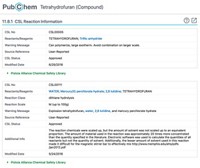Advertisement
Grab your lab coat. Let's get started
Welcome!
Welcome!
Create an account below to get 6 C&EN articles per month, receive newsletters and more - all free.
It seems this is your first time logging in online. Please enter the following information to continue.
As an ACS member you automatically get access to this site. All we need is few more details to create your reading experience.
Not you? Sign in with a different account.
Not you? Sign in with a different account.
ERROR 1
ERROR 1
ERROR 2
ERROR 2
ERROR 2
ERROR 2
ERROR 2
Password and Confirm password must match.
If you have an ACS member number, please enter it here so we can link this account to your membership. (optional)
ERROR 2
ACS values your privacy. By submitting your information, you are gaining access to C&EN and subscribing to our weekly newsletter. We use the information you provide to make your reading experience better, and we will never sell your data to third party members.
Pharmaceuticals
Pharma Leaders Conference focuses on industrial collaboration
Event hosted by ACS and Janssen aims to accelerate drug development
by Susan J. Ainsworth
January 1, 2018
| A version of this story appeared in
Volume 96, Issue 1

In October, the American Chemical Society convened the 15th consecutive ACS Pharma Leaders Conference to provide a forum for some of the pharmaceutical and biotechnology industries’ top chemistry research executives to discuss issues of common concern. Leaders representing about two dozen companies attended the invitation-only meeting at Janssen Research & Development’s Spring House, Pa., campus.
Co-organized by ACS Industry Member Programs and Janssen, this year’s meeting explored areas of mutual interest with the goal of accelerating drug development. The program, “Opportunities for Cross-Pharma Collaboration: Methods for Generating & Optimizing Chemical Matter,” was created by Jim Edwards, global head of Discovery Sciences Chemistry at Janssen Research & Development.
In his keynote address, Mark Rigby, director of immunology translational medicine at Janssen, spoke about Janssen’s efforts to eliminate all disease by 2030. Other presentations covered computational approaches to improving drug discovery, ways to make molecules more efficiently, and a new method for targeted degradation of proteins.
Rick Connell, head of external research solutions at Pfizer, presented an update on the Building Block Forum Initiative, a concept he launched at the 2015 Pharma Leaders Conference. Under the plan, companies are invited to contribute novel, noncommercial monomers and templates to a building block collective. Participants are eligible to swap their existing, unused assets for other compounds of interest in the collective to bolster their screening libraries in support of their programs, Connell said.
MilliporeSigma is set up to administer the collective operation, according to Mike Willis, MilliporeSigma’s head of discovery chemistry and services. MilliporeSigma has assessed the collections of AbbVie, Eli Lilly & Co., GlaxoSmithKline, Roche, and Janssen under a confidential disclosure agreement.
Veerabahu Shanmugasundaram, director of Computational Analysis & Design for Pfizer Worldwide Research & Development, spoke about ongoing collaborations in the precompetitive space that range from binding affinity predictions to protein crystal image classification to synthesis prediction methods. “Over the past few years, computational chemistry group leaders from various companies have been working together to create a strong, vibrant network of scientists who will catalyze the development and application of computational methods,” Shanmugasundaram said. “We have been identifying gaps, sharing data sets, evaluating new methods, and developing best practices that will accelerate capabilities in the field.”
For the first time, the Pharma Leaders agenda included a presentation by the ACS Green Chemistry Institute (GCI) Pharmaceutical Roundtable. Frank Roschangar, cochair of the roundtable and a director at Boehringer Ingelheim Pharmaceuticals, presented the business case for green chemistry and highlighted the major initiatives of the GCI Pharmaceutical Roundtable. Since its creation in 2005, the roundtable has awarded almost $2 million in research grants to address specific green chemistry challenges faced by the pharmaceutical industry. In addition, the roundtable has also developed tools, including reagent and solvent selection guides and the process mass intensity calculator, to promote the implementation of green chemistry across the pharmaceutical industry.
“I look forward to future interactions between the Pharma Leaders Conference and the ACS GCI Pharmaceutical Roundtable,” noted Mary Kirchhoff, director of ACS GCI, which held its fall meeting Oct. 3–5, 2017, at Boehringer Ingelheim in Ingelheim, Germany. “Both groups are focused on working across the pharmaceutical industry in a precompetitive space, forging collaborations that will ultimately benefit both patients and the environment,” she added.
Plans for 2018 include organizing an ACS Pharma Leaders symposium during the ACS fall national meeting, which will allow all ACS members to gain exposure to Pharma Leaders Conference themes and discussions. The inaugural Pharma Leaders symposium, “ACS Pharma Leaders: Working Together to Make a Difference,” was held during the ACS national meeting in Washington, D.C., in August; it was organized by Wendy Young, senior vice president of small-molecule drug discovery at Genentech, and 2016 Pharma Leaders host Phil Kym, director of chemistry at AbbVie.
As a neutral third-party convener, ACS will help facilitate the symposium and other activities. “ACS is committed to supporting the pharma industry in the development of critical therapies and cures aimed at challenging diseases and other health issues,” said Vijay Kuruganti, director of ACS Industry Member Programs.
The next Pharma Leaders Conference will be hosted by Karin Briner, vice president and head of global discovery chemistry at Novartis Institutes for BioMedical Research, in Cambridge, Mass., on Oct. 4–5.



Join the conversation
Contact the reporter
Submit a Letter to the Editor for publication
Engage with us on Twitter